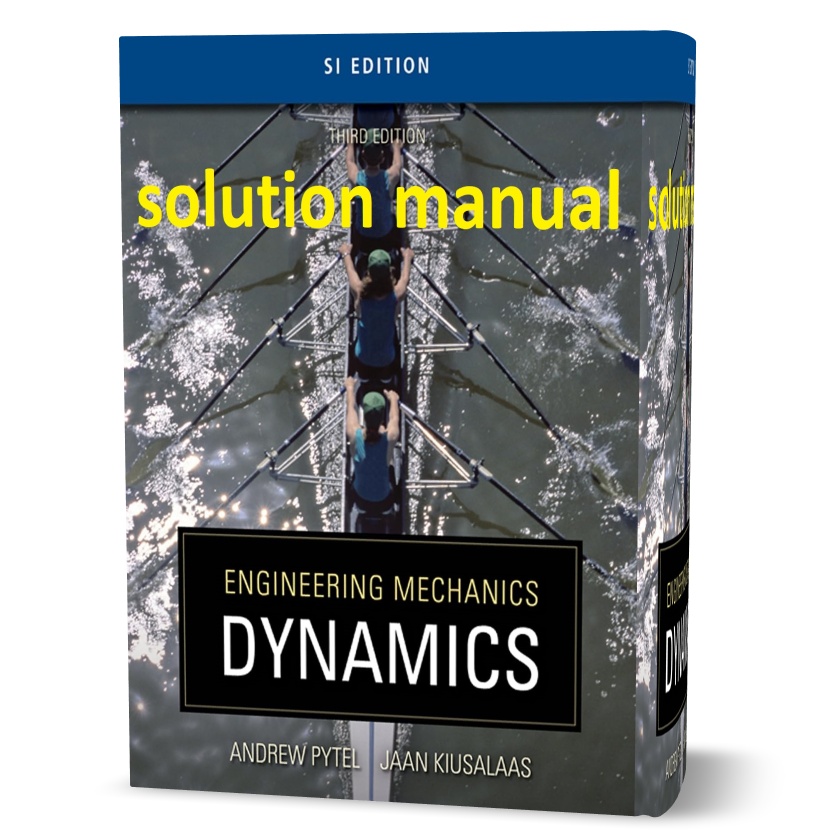


Statics Download free Engineering mechanics dynamics Andrew Pytel Jaan Kiusalaas 3rd & 4th Solutions Manual pdf and dynamics are basic subjects in the general field known as engineering mechanics. At the risk of oversimplifying, engineering mechanics is that branch of engineering that is concerned with the behavior of bodies under the action of forces. Statics and dynamics form the basis for many of the traditional fields of engineering, such as automotive engineering, civil engineering, and mechanical engineering. In addition, these subjects often play fundamental roles when the principles of mechanics are applied to such diverse fields as medicine and biology. for more ebook solutions click here.
Click Below link To Download file
Applying the principles of statics and dynamics to such a wide range of applications requires reasoning and practice rather than memorization. Although the principles of statics and dynamics are relatively few, they can only be truly mastered by studying and analyzing problems. Therefore, all modern textbooks, including ours, contain a large number of problems to be solved by the student. Learning the engineering approach to problem solving is one of the more valuable lessons to be learned from the study of statics and dynamics.
We have made every effort to improve our presentation without compromising the following principles that formed the basis of the previous editions. Download free Engineering mechanics dynamics Andrew Pytel Jaan Kiusalaas 3rd & 4th Solutions Manual pdf
• Each sample problem is carefully chosen to help students master the intricacies of engineering problem analysis.
• The selection of homework problems is balanced between “textbook” problems that illustrate the principles of engineering mechanics in a straight-forward manner, and practical engineering problems that are applicable to engineering design.
• The number of problems using U.S. Customary Units and SI Units are approximately equal.
• The importance of correctly drawn free-body diagrams is emphasized throughout.
• We continue to present equilibrium analysis in three separate articles, each followed by a set of problems.
The second shows how to write and solve the equilibrium equations using a given free-body diagram. The third article combines the two techniques just learned to arrive at a logical plan for the complete analysis of an equilibrium problem.
• Whenever applicable, the number of independent equations is compared to the number of unknown quantities before the governing equations are written.
• Review Problems appear at the end of chapters to encourage students to synthesize the individual topics they have been learning.
We have included several optional topics, which are marked with an asterisk (*). Due to time constraints, topics so indicated can be omitted without jeopardizing the presentation of the subject. An asterisk is also used to indicate problems that require advanced reasoning. Articles, sample problems, and problems associated with numerical methods are preceded by an icon representing a computer disk.
we have made a number of significant improvements based upon the feedback received from students and faculty who have used the previous editions. In addition, we have incorporated many of the suggestions provided by the reviewers of the second edition.
A number of articles have been reorganized, or rewritten, to make the topics easier for the student to understand. For example, our presentation of beam analysis in Chapter 6 has been completely rewritten and includes both revised sample problems and revised problems. Our discussion of beams now more clearly focuses upon the methods and terminology used in the engineering analysis and design of beams. Also, the topic of rolling resistance has been added to Chapter 7. Furthermore, our discussion of virtual displacements in Chapter 10 has been made more concise and therefore will be easier for the students to understand. New to this edition, sections entitled Review of Equations have been added at the end of each chapter as a convenience for students as they solve the problems.
Click Below link To Download file
برچسب های مهم